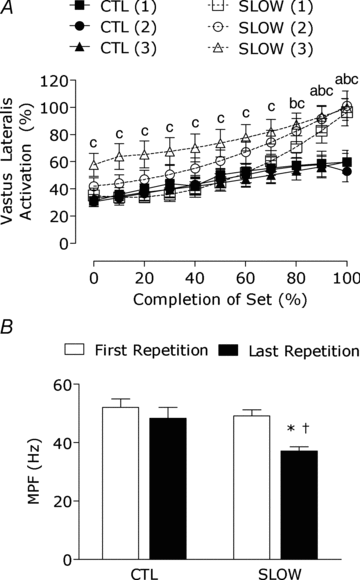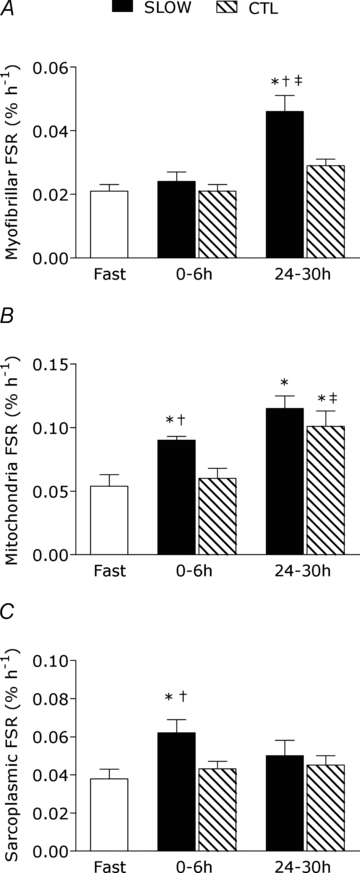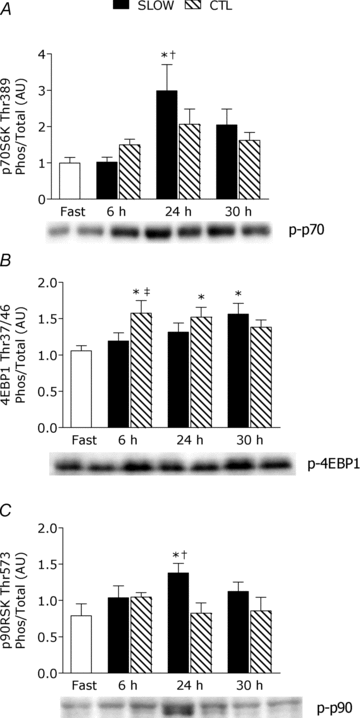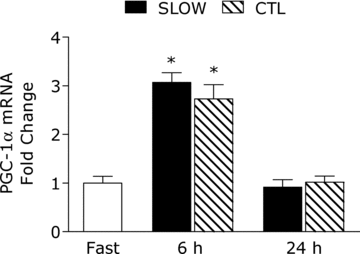Muscle time under tension during resistance exercise stimulates differential muscle protein sub-fractional synthetic responses in men - PubMed (original) (raw)
Clinical Trial
Muscle time under tension during resistance exercise stimulates differential muscle protein sub-fractional synthetic responses in men
Nicholas A Burd et al. J Physiol. 2012.
Abstract
We aimed to determine if the time that muscle is under loaded tension during low intensity resistance exercise affects the synthesis of specific muscle protein fractions or phosphorylation of anabolic signalling proteins. Eight men (24 ± 1 years (sem), BMI = 26.5 ± 1.0 kg m(-2)) performed three sets of unilateral knee extension exercise at 30% of one-repetition maximum strength involving concentric and eccentric actions that were 6 s in duration to failure (SLOW) or a work-matched bout that consisted of concentric and eccentric actions that were 1 s in duration (CTL). Participants ingested 20 g of whey protein immediately after exercise and again at 24 h recovery. Needle biopsies (vastus lateralis) were obtained while fasted at rest and after 6, 24 and 30 h post-exercise in the fed-state following a primed, constant infusion of l-[ring-(13)C(6)]phenylalanine. Myofibrillar protein synthetic rate was higher in the SLOW condition versus CTL after 24-30 h recovery (P < 0.001) and correlated to p70S6K phosphorylation (r = 0.42, P = 0.02). Exercise-induced rates of mitochondrial and sarcoplasmic protein synthesis were elevated by 114% and 77%, respectively, above rest at 0-6 h post-exercise only in the SLOW condition (both P < 0.05). Mitochondrial protein synthesis rates were elevated above rest during 24-30 h recovery in the SLOW (175%) and CTL (126%) conditions (both P < 0.05). Lastly, muscle PGC-1α expression was increased at 6 h post-exercise compared to rest with no difference between conditions (main effect for time, P < 0.001). These data show that greater muscle time under tension increased the acute amplitude of mitochondrial and sarcoplasmic protein synthesis and also resulted in a robust, but delayed stimulation of myofibrillar protein synthesis 24-30 h after resistance exercise.
Figures
Figure 1. Schematic diagram of the experimental infusion protocols
Double arrows indicate bilateral biopsies were obtained at corresponding time points. Subjects consumed 20 g of whey protein isolate at the feeding time points.
Figure 2. Percentage increase in vastus lateralis activation during the concentric phase of resistance exercise (A) and the change in mean power frequency (MPF) during the isometric phase of resistance exercise from the first repetition to the last repetition (B)
Numbers in parentheses following SLOW indicate set number. Lower case letter indicates significantly different from CTL for sets 1–3: a, SLOW(1); b, SLOW(2); c, SLOW(3); P < 0.05. *Significantly different from 0% set completion, P < 0.05. †Significantly different from CTL at that time point, P < 0.05.
Figure 3. Myofibrillar (A), mitochondrial (B), and sarcoplasmic (C) protein fractional synthetic rates (FSR) during protocols
Note different scales on _y_-axes between graphs. Rates are from rested fasted and after resistance exercise with slow (SLOW) or external work match control (CTL) muscle time under tension. Values are means ± S.E.M. *Significantly different from fasting, P < 0.05. †Significantly different from CTL at that same time point, P < 0.05. ‡Significantly different from the 0–6 h response in the same condition, P < 0.05.
Figure 4. Ratio of phosphorylated to total of p70S6KThr389 (A), 4E-BP1Thr37/46 (B) and p90RSKThr573 (C) during the protocols
Ratios are from rested fasted and after resistance exercise with slow (SLOW) or external work match control (CTL) muscle time under tension. Values are means ± S.E.M. Data are expressed in arbitrary units (AU). *Significantly different from fast, P < 0.05. †Significantly different from CTL within that time point, P < 0.05. ‡Significantly different from SLOW within that time point, P < 0.05.
Figure 5. Peroxisome proliferator-activated receptor γ coactivator 1-α (PGC-1α) mRNA content at fast, 6 h and 24 h post-exercise
*Significantly different from fasting, P < 0.05.
Similar articles
- Resistance exercise volume affects myofibrillar protein synthesis and anabolic signalling molecule phosphorylation in young men.
Burd NA, Holwerda AM, Selby KC, West DW, Staples AW, Cain NE, Cashaback JG, Potvin JR, Baker SK, Phillips SM. Burd NA, et al. J Physiol. 2010 Aug 15;588(Pt 16):3119-30. doi: 10.1113/jphysiol.2010.192856. Epub 2010 Jun 25. J Physiol. 2010. PMID: 20581041 Free PMC article. Clinical Trial. - Short inter-set rest blunts resistance exercise-induced increases in myofibrillar protein synthesis and intracellular signalling in young males.
McKendry J, Pérez-López A, McLeod M, Luo D, Dent JR, Smeuninx B, Yu J, Taylor AE, Philp A, Breen L. McKendry J, et al. Exp Physiol. 2016 Jul 1;101(7):866-82. doi: 10.1113/EP085647. Epub 2016 Jun 2. Exp Physiol. 2016. PMID: 27126459 - Fasted-state skeletal muscle protein synthesis after resistance exercise is altered with training.
Kim PL, Staron RS, Phillips SM. Kim PL, et al. J Physiol. 2005 Oct 1;568(Pt 1):283-90. doi: 10.1113/jphysiol.2005.093708. Epub 2005 Jul 28. J Physiol. 2005. PMID: 16051622 Free PMC article. - Differential stimulation of myofibrillar and sarcoplasmic protein synthesis with protein ingestion at rest and after resistance exercise.
Moore DR, Tang JE, Burd NA, Rerecich T, Tarnopolsky MA, Phillips SM. Moore DR, et al. J Physiol. 2009 Feb 15;587(Pt 4):897-904. doi: 10.1113/jphysiol.2008.164087. Epub 2009 Jan 5. J Physiol. 2009. PMID: 19124543 Free PMC article. - Muscle protein synthesis in response to nutrition and exercise.
Atherton PJ, Smith K. Atherton PJ, et al. J Physiol. 2012 Mar 1;590(5):1049-57. doi: 10.1113/jphysiol.2011.225003. Epub 2012 Jan 30. J Physiol. 2012. PMID: 22289911 Free PMC article. Review.
Cited by
- Effects of Cross-Education After 6 Weeks of Eccentric Single-Leg Decline Squats Performed With Different Execution Times: A Randomized Controlled Trial.
Martínez F, Abián P, Jiménez F, Abián-Vicén J. Martínez F, et al. Sports Health. 2021 Nov-Dec;13(6):594-605. doi: 10.1177/19417381211016353. Epub 2021 Jun 2. Sports Health. 2021. PMID: 34075821 Free PMC article. Clinical Trial. - Transcriptional and morphological responses following distinct muscle contraction protocols for Snell dwarf (Pit1dw/dw) mice.
Rader EP, McKinstry KA, Baker BA. Rader EP, et al. Physiol Rep. 2024 Sep;12(17):e70027. doi: 10.14814/phy2.70027. Physiol Rep. 2024. PMID: 39227324 Free PMC article. - A review of resistance training-induced changes in skeletal muscle protein synthesis and their contribution to hypertrophy.
Damas F, Phillips S, Vechin FC, Ugrinowitsch C. Damas F, et al. Sports Med. 2015 Jun;45(6):801-7. doi: 10.1007/s40279-015-0320-0. Sports Med. 2015. PMID: 25739559 Review. - Training to Fatigue: The Answer for Standardization When Assessing Muscle Hypertrophy?
Dankel SJ, Jessee MB, Mattocks KT, Mouser JG, Counts BR, Buckner SL, Loenneke JP. Dankel SJ, et al. Sports Med. 2017 Jun;47(6):1021-1027. doi: 10.1007/s40279-016-0633-7. Sports Med. 2017. PMID: 27677915 - Effects of Lengthening Velocity During Eccentric Training on Vastus Lateralis Muscle Hypertrophy.
Marzilger R, Bohm S, Mersmann F, Arampatzis A. Marzilger R, et al. Front Physiol. 2019 Jul 31;10:957. doi: 10.3389/fphys.2019.00957. eCollection 2019. Front Physiol. 2019. PMID: 31417420 Free PMC article.
References
- Atherton PJ, Etheridge T, Watt PW, Wilkinson D, Selby A, Rankin D, Smith K, Rennie MJ. Muscle full effect after oral protein: time-dependent concordance and discordance between human muscle protein synthesis and mTORC1 signaling. Am J Clin Nutr. 2010;92:1080–1088. - PubMed
- Burd NA, West DW, Moore DR, Atherton PJ, Staples AW, Prior T, Tang JE, Rennie MJ, Baker SK, Phillips SM. Enhanced amino acid sensitivity of myofibrillar protein synthesis persists for up to 24 h after resistance exercise in young men. J Nutr. 2011a;141:568–573. - PubMed
- Burd NA, West DW, Staples AW, Atherton PJ, Baker JM, Moore DR, Holwerda AM, Parise G, Rennie MJ, Baker SK, Phillips SM. Low-load high volume resistance exercise stimulates muscle protein synthesis more than high-load low volume resistance exercise in young men. PLoS One. 2010b;5:e12033. - PMC - PubMed
Publication types
MeSH terms
Substances
LinkOut - more resources
Full Text Sources
Other Literature Sources
Medical




